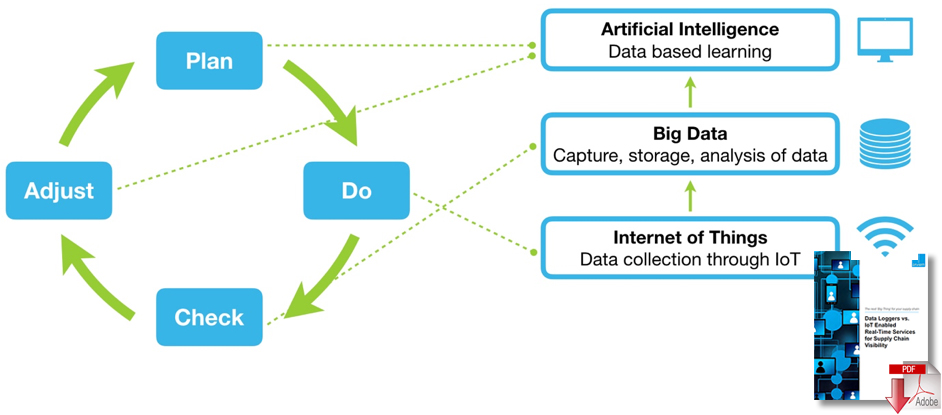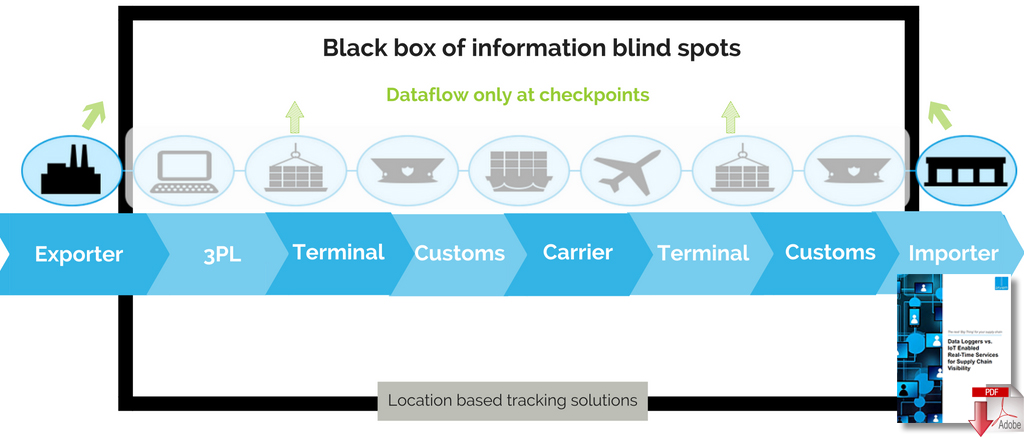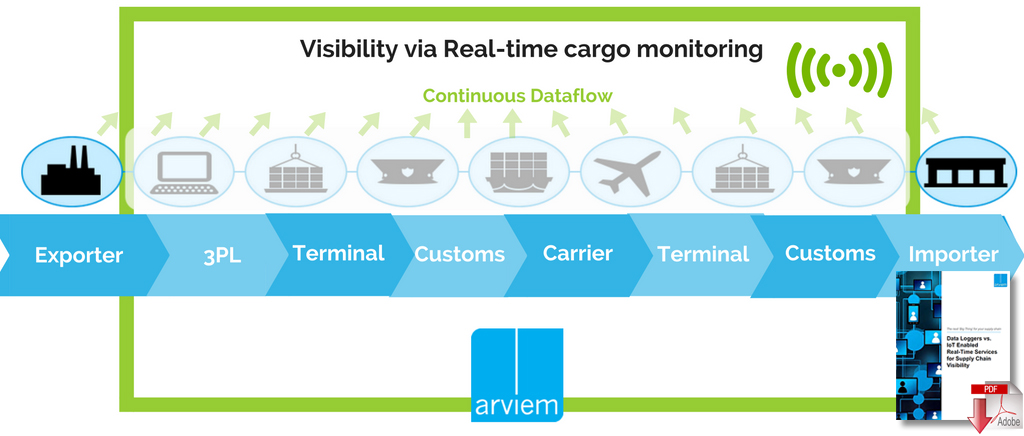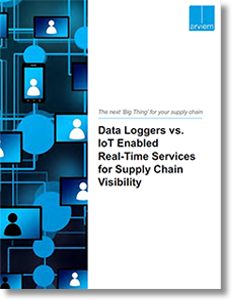How the Internet of Things & Big Data Are Accelerating Supply Chain Management
IoT technology along with big data analytics is well on its way to transforming supply chain management, and the companies that can take advantage of these benefits in the near term will save money, increase efficiency and keep their customers happy.


IoT and Big Data
The Internet of Things (IoT) and Big Data are becoming one of those technologies that are being incorporated into our daily lives as the number of devices connected to the internet is increasing at a fast pace.
Physical devices connected to the internet, so-called IoT devices, share a huge amount of data.
The goal of any organization dealing with the pool of connected sensors is to harness the data produced and learn patterns and trends out of it.
According to a study by Gartner, the revenue generated from IoT-enabled services and products will exceed $300 billion by 2020.
This, however, is only the tip of the iceberg.
IoT will generate a vast amount of data, and in today’s world, well-analyzed data is extremely valuable.
Big data analytics tools have the capability to handle large volumes of data generated from IoT devices.
IoT delivers the data collected from various sensors and the big-data analytics tools can be used to store and create insights from this information.
Unique IoT services create niche opportunities to improve customer value.
For example, the enormous amount of data gathered from sensors can be analyzed in real time to derive conclusions that can help to make informed decisions for continuous improvements within operations.
The patterns and trends observed from the enormous amount of data are used by several machine learning algorithms and help in making predictive analytics with data-based learning.
IoT and Big Data analytics help businesses to go from being reactive to being proactive
With big data analytics, problems can be fixed by predicting them before they happen.
IoT in collaboration with big data analytics helps businesses go from being reactive to being proactive.
Also, the prescriptive insights obtained from big data lead to a decrease in the risk of damage and waste, thereby generating more effective operational results and revenue potential.
The following statistics from Gartner shows how evident and revolutionary IoT and big data is in our everyday lives:
- By 2020 every person will create 1.7 MB of data every single second.
- There are 3.5 billion Google searches per day and 400 hours of new Youtube video added every minute.
- The number of IoT connected devices is forecast to reach up to 30 billion by 2020.
- IoT investment is expected to reach $58.14 trillion in the next 15 years.
“IoT and big data are knitted together. The IoT drives big data, providing more information, from several different sources in real-time, and allows to gain completely new perspectives on the environment around us.”

IoT and Big Data play an important role in almost all the industrial sectors and provide a transformative potential for many such as Healthcare, Retail, Manufacturing, Financial Services, Banking and insurance, Education, Transportation, Supply chain management, Logistics, and Agriculture.
IoT & Big Data in the Supply Chain
According to a report from Transparency Market Research, the global supply chain and logistics market are set to exceed $15 trillion by 2023.
Despite the rapid growth of the supply chain industry, there has not been much groundbreaking innovation happening in the field and the companies still face inefficiencies.
Based on a report by ZenCargo, supply chain inefficiencies cost businesses nearly USD 2 Billion in the UK alone.
The entire supply chain management process is complex. It involves a large amount of point-to-point communication with outdated processes that are heavily dependent on email and phone communication. It involves controlling and monitoring a product’s flow from the procurement of raw materials to the distribution of the final product to the end user.
While the product transits through various locations, its monitoring and controlling is crucial in order to ensure efficient planning and production processes. Despite the availability of several technological solutions, many companies still lack end to end visibility to their entire supply chain. This is due to the silos existing between people, processes and technology.
This leads to inefficiencies as the supply chain is slowed down by the large and complex network of point-to-point communications.
“IoT is on the rise towards restructuring the entire process by which supply chains operate.”
IoT is on the rise towards restructuring the entire process by which supply chains operate. The power of IoT lies in intelligently connecting people, processes, data and things via devices and sensors creating a networked ecosystem of things continuously measuring, collecting and exchanging ‘live’ data. Supply chains benefit from live data as it provides unprecedented visibility into every process and transaction within the supply chain.
IoT enabled sensor devices that provide input for supply chain analytics dashboards present opportunities for supply chain leaders to have better access to real-time data and transform today’s outdated supply chain structures and create the supply chains of the future that are hyperconnected, innovative, transparent and intelligent.
IoT and Big Data are revealing supply chain inefficiencies by eliminating blind spots from logistics processes
One of the many ways to utilize IoT for the supply chain is IoT enabled cargo monitoring.
Today the visibility into the movement of goods is still minimal and mostly done via processes heavily dependent on phone calls, paperwork and email communication.
The traditional supply chain visibility concept is milestone-based, resulting in logistics blind spots for the shippers. Data about the status of assets is only recorded when goods reach certain checkpoints or milestone. In-between the checkpoints, companies lack the visibility to know where their inventory is located, whether carriers are providing the right service levels, and where are the bottlenecks and inefficiencies are in the supply chain.

With the help of IoT enabled real-time cargo tracking and monitoring, companies can replace milestone-based tracking solutions and benefit from automated end-to-end in-transit visibility from the point of manufacture to the point of delivery.
Real-time cargo tracking and monitoring services based on IoT and Big data analytics offer capabilities that set exporters and importers apart from their competition. It connects intermodal shipping containers, cargo, vessels, and trailers with enterprise IT systems via the use of sensors, GPS, mobile networks and a cloud-based platform.
The sensors capture and transmit signals and data to provide a closer picture of the condition, geographical location and environment of goods in transit.
By having the possibility to access this data at any time from anywhere, supply chain leaders are empowered to take proactive actions and make fast and smart decisions when it comes to the unplanned, distracting events and delays in the supply chain.

Monitoring the condition and the environment of shipments in real time allows clients to verify the whole journey of a product; predict, correct, and even prevent problems with the help of faster response time. Clients know whether their cargo has been tampered with, whether it has experienced any significant shocks or temperature fluctuations that might have negatively affected the quality of the product.
Fully transparent supply chains allow companies to sense and respond to disruptions in the supply chains with extreme precision. It reveals insights that enable logistics and supply chain professionals to optimize shipping routes by defining safe and optimal routes, to evaluate carrier performance levels against benchmarks, to analyze logistics carbon footprint, to improve the security of cargo and to reduce business risk.
All in all, IoT technology along with big data analytics is well on its way to transforming supply chain management. The companies that can take advantage of these benefits in the near term will save money, increase efficiency and keep their customers happy.

Related Article Chain of Custody: Source of Control in Global Supply Chains
Related White Paper
Data Loggers vs. IoT Enabled Real-Time Services for Supply Chain Visibility
Learn how to optimize your supply chain processes and eliminate inefficiencies with the help of supply chain visibility solutions and cargo tracking and monitoring. Download Now!

Article Topics
Latest in Materials Handling
U.S-bound May imports continue to grow, reports S&P Global Market Intelligence AGILOX North America opens new headquarters, announces new CEO Auriemma becomes new CEO of Business Unit Software at Körber Expo Pack México 2024 sets new records Hai Robotics announces move of its Americas headquarters to Atlanta metro Glencore improves recycling plant safety with ELOKON’s proximity detection system National Forklift Safety Day: Yale Reliant operator assistance technology reaches 14 million hours of real-world run time More Materials HandlingSubscribe to Materials Handling Magazine

Find out what the world's most innovative companies are doing to improve productivity in their plants and distribution centers.
Start your FREE subscription today.
June 2024 Modern Materials Handling

Latest Resources












